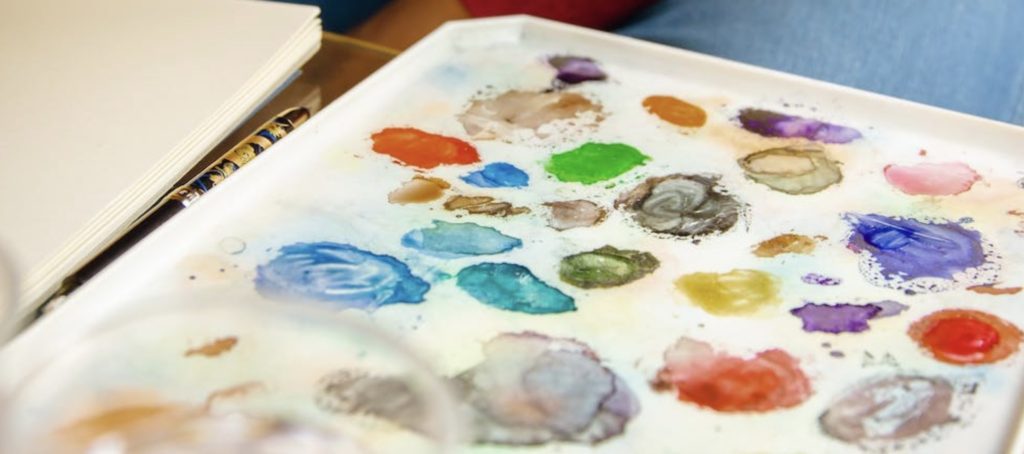Watercolor is a versatile, and commonly used, paint for artists. It is known for its transparency and molubility. In this post, I will explain how to paint with watercolor on canvas and some great techniques.
What is Special About Watercolor?
- Transparency: Unlike other paint mediums, watercolor is transparent. This means that the colors can be layered to create luminous, glowing effects. Also, transparent quality of watercolor also allows the white of the paper to show through. This adds to the brightness and vibrancy of the colors.
- Water-soluble: Watercolor is water-soluble, which means that it can be easily mixed with water to create a range of effects. This makes it a versatile medium that can be used for both subtle and bold expressions.
- Unpredictable: Watercolor is known for its unpredictability, which can be both a challenge and an opportunity for artists. The way the paint interacts with water and the paper can produce unexpected effects. This can add to the excitement and creativity of the painting process.
- Portability: Watercolor is a highly portable medium, which makes it a popular choice for plein air painting or for artists who like to paint on the go. Watercolor paints and paper can be easily transported in a compact set. Therefore, it is an ideal choice for travel or outdoor painting.
- Quick-drying: Watercolor dries quickly, which allows artists to work quickly and make changes easily. This also makes it easier to create layer upon layer of color, as the previous layers dry quickly and don’t mix with the subsequent layers.

How Painting on Canvas is Different from Watercolor on Paper
Painting with watercolor on canvas can produce beautiful results. However, it does require some adjustments compared to watercolor on paper:
The main difference is that canvas is not as absorbent as paper. Therefore, the paint tends to sit on top of the surface rather than soak in. To overcome this, you’ll need to prime the canvas with an absorbent ground before painting.
Once you’ve prepped the canvas, you can begin by laying down your washes of color. This starts with light colors and gradually building up to darker shades. Be sure to work quickly and allow each layer to dry completely before adding more. This is becasue watercolor tends to bleed and blend together when wet.
You can also use a variety of techniques such as wet-on-wet, dry brush, and lifting to create interesting textures and effects. One advantage of painting on canvas is that you can create larger pieces with more texture and dimension than on paper. However, canvas can be more challenging to work with, as the paint can easily lift off or be difficult to control. With practice and experimentation, you can create stunning watercolor paintings on canvas that stand out from traditional watercolor on paper.
Different Options for Painting with Watercolor on Canvas:
Watercolor Canvases
You have a few different options for if you want to paint with watercolor on canvas. Your first option is buying watercolor canvases. They make a lot of canvases that are made specifically for different mediums.
The surface of a watercolor canvas is treated with a special coating that allows the paint to absorb properly and adhere better. Then, this results in more vibrant colors and a more even finish. Additionally, watercolor canvases are typically made from high-quality, archival materials. This means they will stand the test of time, ensuring that your artwork will last for years to come. Watercolor canvases are also more resistant to warping and buckling than traditional canvases. This allows you to work with confidence and precision.
You can find great option for watercolor canvases on amazon. If you dont have any canvases already for yourself, I would defiantly just buy one from online or in store.
Gesso
Gesso is an essential material for priming canvases for watercolor painting. When applied to a canvas, gesso creates a smooth, non-porous surface. This allows the watercolor paint to adhere properly and absorb properly.
Without gesso, the paint may not adhere well, resulting in a dull, uneven finish. Gesso also helps to prevent the paint from soaking into the canvas. This can cause the fibers to weaken over time and lead to deterioration of the artwork. Additionally, gesso can be sanded to create a smooth, even surface, which is important for achieving precise, detailed watercolor paintings.
You can even use gesso to build up parts of the canvas, or create unique texture!
If you are buying a canvas from the store that is not watercolor ready, it is most likely already gesso-ed. I dont think that just a gesso-ed canvas is the best for watercolor though. I would not recommend this as your option for watercolor painting on a canvas.
Absorbent Ground
If you already have gesso-ed canvases at home like me, this is the best option for you!
Absorbent ground is a specially designed primer for painting with watercolor on canvas. Unlike traditional gesso, absorbent ground creates a surface that is more absorbent. This allows the watercolor paint to soak in and spread out more easily. This results in more vibrant colors and a smoother, more even finish.
Additionally, absorbent ground helps to prevent the paint from beading up or pooling on the surface of the canvas. This is a common issue when painting with watercolors. Absorbent ground also helps to reduce the risk of the paint seeping through the canvas, which can lead to a weakened canvas over time.

